Email & SMS Consent: GDPR, PECR & Opt-In Compliance Practices
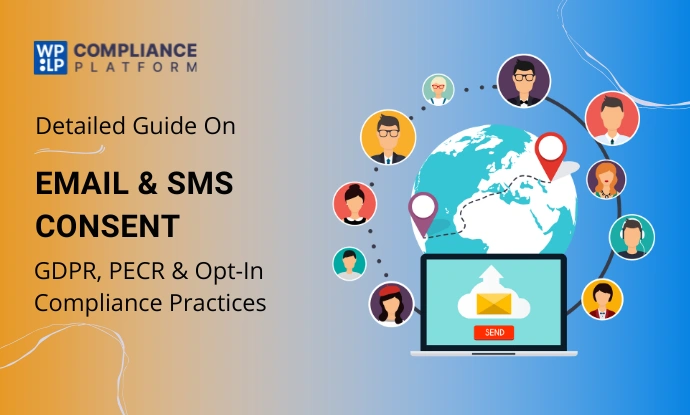
Summary
People make some common mistakes in compliance, like using old lists or pre-filled boxes, but this can get you in trouble. Some best practices you can follow to avoid fines and stay compliant are double opt-in, preference centers, and audit trail maintenance.
Solutions like the WPLP Compliance Platform, which are designed to automate consent capture, logging, and audits specifically for WordPress users, thus simplify compliance while building customer confidence.
Could your promotional emails or SMS messages land you a heavy fine?
Across the globe, regulators are tightening the laws on marketing consent.
From GDPR penalties in Europe to CAN-SPAM and TCPA fines in the US, companies are having a hard time sending messages without the proper consent.
Email and SMS marketing are powerful ways to engage customers, but they come with strict compliance requirements under global privacy laws.
This guide will discuss key laws and rules governing email and SMS marketing.
And we will provide you with the best practices for capturing and managing opt-in consent. And how tools like the WPLP Compliance Platform can automate consent storage and audit logs.
By the end, you’ll know how to protect your business from fines while building trust-based, compliant marketing campaigns. So read till the end.
- Why Email & SMS Consent Matters: The Legal & Business Risks
- Overview of Consent Laws: GDPR, PECR, CAN-SPAM, and Global Trends
- What Counts as Valid Email/SMS Consent?
- Common Compliance Mistakes & How to Fix Them
- Best Practices for Capturing, Logging, and Managing Consent
- Practical Tools for Automated Consent Compliance
- Responding to Complaints/Regulatory Checks
- Frequently Asked Questions (FAQ)
- Conclusion
Why Email & SMS Consent Matters: The Legal & Business Risks
Consent for marketing is a legal requirement.
If a marketer or business fails to properly obtain email consent under GDPR or SMS marketing privacy properly, this can lead to severe penalties.
Laws define how businesses handle customer data and market it.
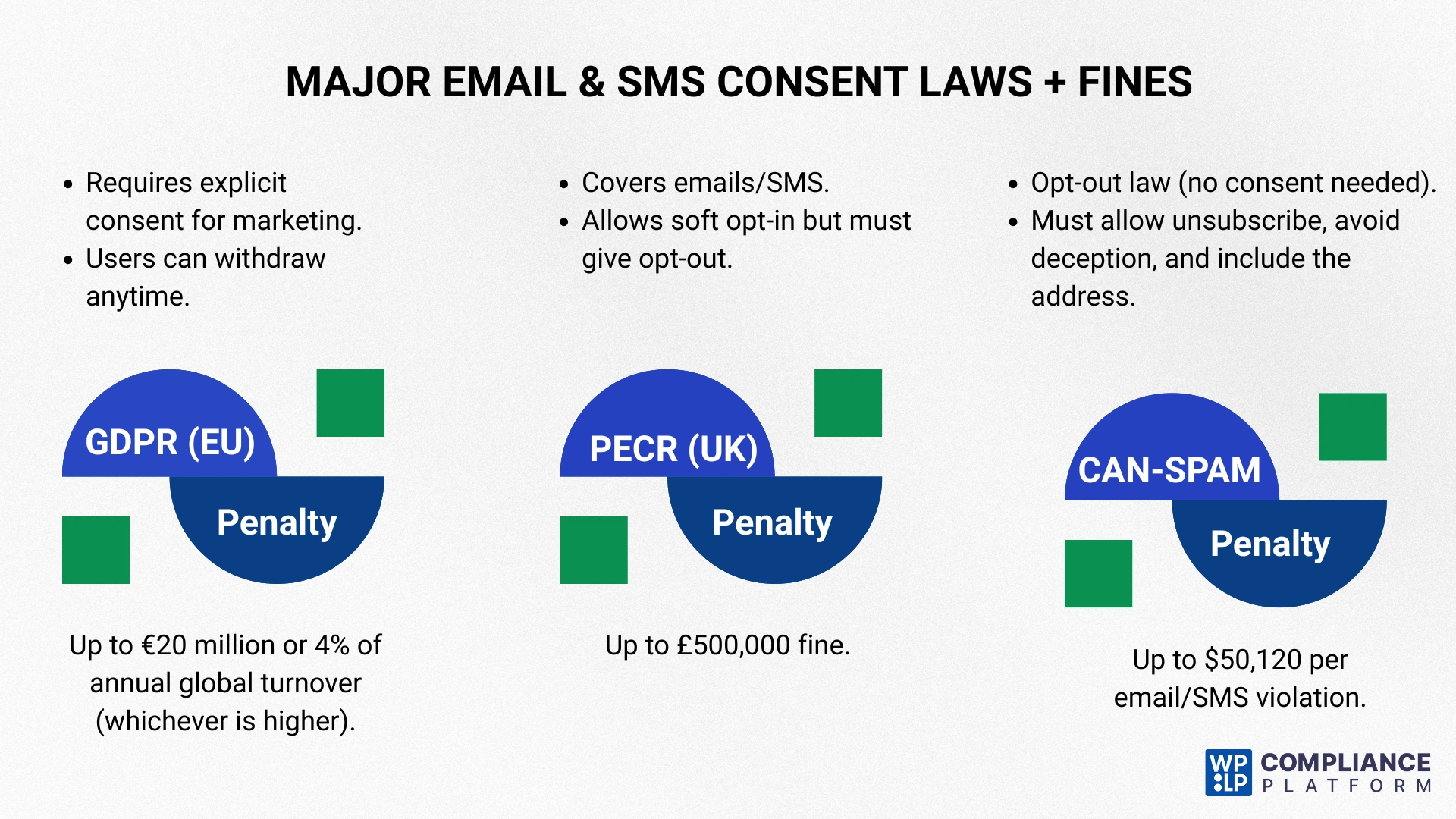
- GDPR (EU): Sets the global standard for data privacy. Give users the right to withdraw consent anytime.
- PECR (UK): Works alongside GDPR, covering electronic marketing. Requires soft opt-in for emails/SMS, but allows messages to existing customers if an opt-out option is provided. These PECR marketing rules every business must follow.
- CAN-SPAM (US): An opt-out law for commercial emails. No prior consent is needed, but you must provide easy unsubscribe options.
If these laws are not followed, regulating bodies can fine you up to a million.
The GDPR fines can reach up to €20 million or 4% of a company’s annual global turnover.
In the UK, PECR fines can reach £500,000. At the same time, text message marketing fines under TCPA can reach up to $50,120 per violation.
The Most Recent High-Profile Cases:
- HelloFresh (UK): The ICO issued a fine of £140,000 to HelloFresh for sending over 80 million marketing emails and SMS without obtaining the appropriate consent. The company bundled various consents into one checkbox, breaching GDPR/PECR regulations that ‘consent’ has to be specific.
- Amazon (EU): Amazon was charged €700M+ under GDPR for unclear data processing and targeted advertising practices. Regulators found they lacked transparency in explaining how user data was collected and used.
- Sumco Panama (US): In 2022, the FCC issued a fine of $299 million to Sumco Panama under the TCPA for making over 5 billion robocalls without consent to US consumers, mainly relating to selling fake car warranties.
Opt-in compliance isn’t just about your legal risks. It’s a basic best practice in email and SMS marketing. If not followed, it can impact your sender reputation and deliverability (your ability for your email/SMS to land in the inbox instead of the spam folder).
A good sender reputation based on high engagement and lower complaint rates tells ESPs that you are a legitimate sender, and, therefore, they will prioritize your messages and deliver them to the inbox. If your messages aren’t getting seen, then your marketing is wasted.
Let’s look at some laws that set rules for sending marketing emails or SMS.
Overview of Consent Laws: GDPR, PECR, CAN-SPAM, and Global Trends
To avoid legal penalties, marketers should be aware of the core principles of major regulations and how they apply to different communication channels.
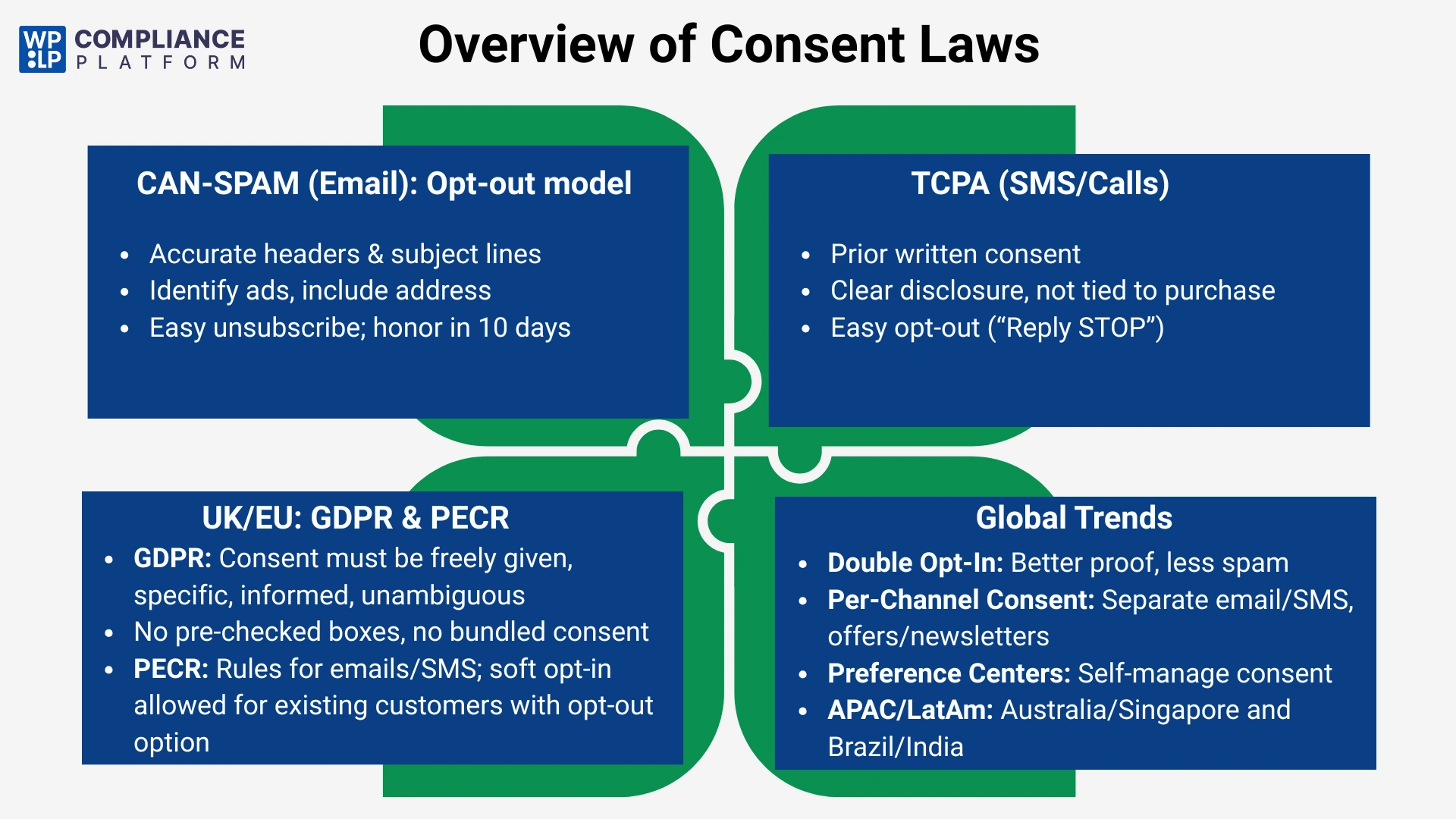
1. UK/EU: GDPR & PECR
The European Union and the UK have their own version of the GDPR (General Data Protection Regulation). These are based on the principle of ‘privacy by design, which requires businesses to consider their users’ privacy in the first instance.
If we talk about email consent GDPR, it sets the bar high for consent. It says the consent must be given freely, specifically, informed, and unambiguous.
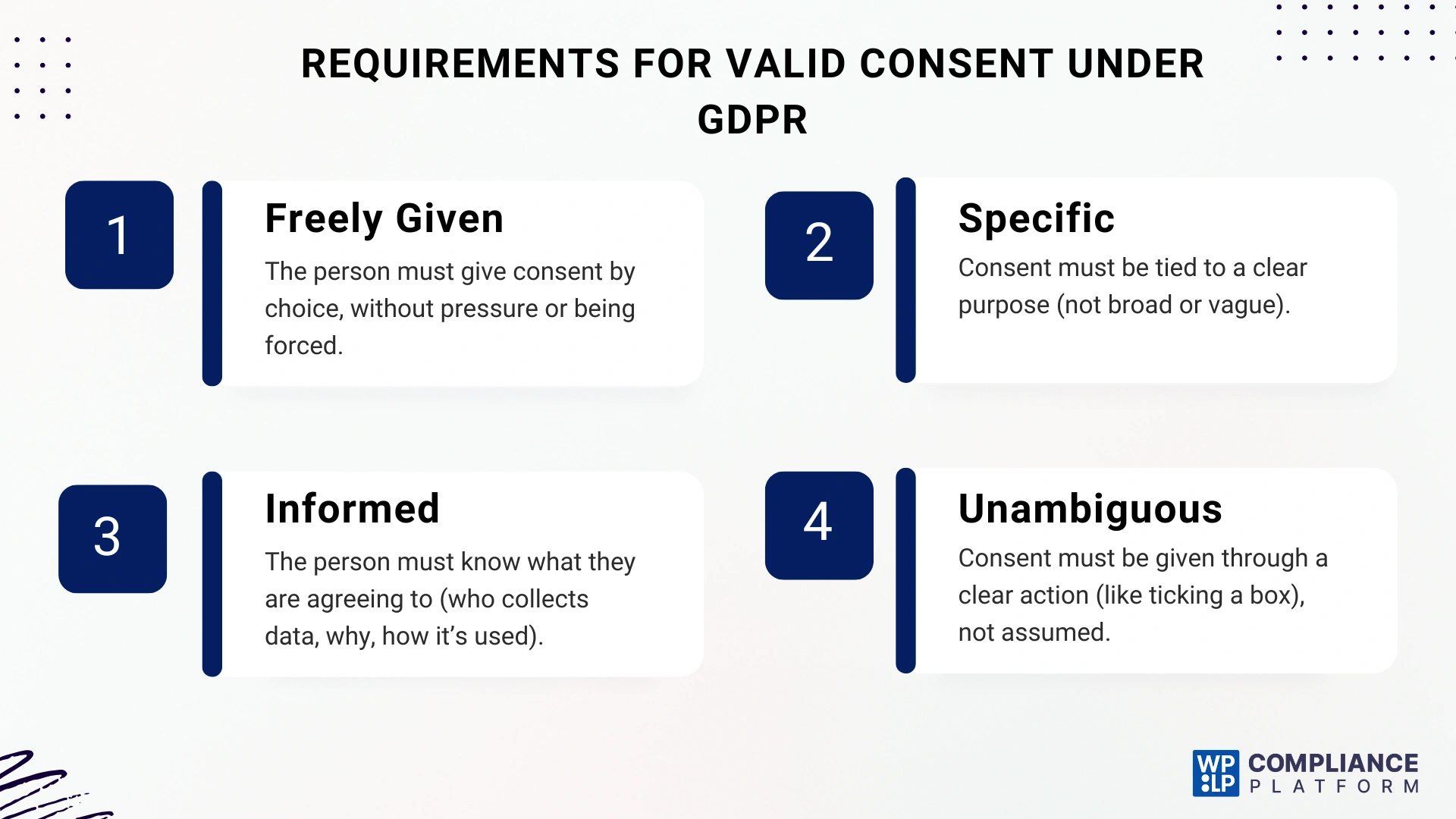
On the other hand, the PECR marketing rules (Privacy and Electronic Communications Regulations) work in conjunction with the GDPR in the UK. It provides specific rules for marketing calls, faxes, emails, and SMS messages.
Soft Opt-In: You can only send your marketing emails to an existing customer without their explicit consent under the following conditions:
- You obtained their contact information during the sale or negotiations of a sale.
- If you are showcasing your own product or services.
- You gave them a clear and simple opportunity to refuse or unsubscribe when you originally collected their details.
2. US: CAN-SPAM
In general, the approach the US takes to consent is less strict than the EU on email. But they have separate laws, more stringent for SMS marketing privacy.
The CAN-SPAM Act stands for Controlling the Assault of Non-Solicited Sexually Pornographic and Marketing Act. It governs commercial email and is an “opt-out” rather than an “opt-in” model.
This means you can send a commercial email to someone without their prior consent, as long as you meet the following requirements:
- Don’t use false or misleading header information.
- Don’t use deceptive subject lines.
- Identify the message as an advertisement.
- Include your physical postal address.
- Provide a clear and straightforward way to opt out of future emails.
- Honor opt-out requests promptly (within 10 business days).
3. TCPA
TCPA (Telephone Consumer Protection Act) is the US law that makes opt-in compliance mandatory for calls and SMS. It requires “prior express written consent” before sending an automated text message or marketing via autodialer. The consent must be:
- A signed written agreement (or it can be electronic).
- Clear and easily seen.
- Not a condition of a purchase.
- The user must be informed about the automated message they receive.
- Every message includes a simple method to opt-out, such as “Reply STOP to unsubscribe.”
New Trends in Global Consent
The legal landscape is not static. As the technology evolved, more countries passed their own global laws. Some new trends that we have seen are.
- Double Opt-In (DOI): This approach reduces spam complaints and provides better audit trails. This creates stronger proof of consent, aligning with GDPR email consent best practices.
- Per-Channel and Per-Purpose Consent: Separate toggles for email vs SMS and for newsletters, offers, product updates, etc. A customer might consent to email marketing but not SMS, or vice versa. This shows respect for customer preferences and is a key component of modern compliance.
- Granular Preference Centers: Self-service centers to view/change/withdraw consent by channel/purpose.
- APAC/LatAm Expansion:
- Australia (Spam Act) & Singapore (PDPA + DNC): Opt-in compliance concept for marketing, strict opt-outs.
- Brazil (LGPD): consent-based processing; opt-outs create a clear withdrawal.
- India (TRAI DLT for SMS): verification for sender IDs/templates, explicit consent, opt-out keywords allowed.
What Counts as Valid Email/SMS Consent?
Under privacy laws, not all “yes” are equal. To be legally defensible, consent must meet an elevated standard.
For consent to be legally valid under email consent GDPR and similar laws, it must tick all four pillars.
For the best practice of consent forms, ensure that you are using all unchecked boxes and maintaining a record of consent, providing an easy way to withdraw consent.
If you follow these practices, then your consent will be counted as valid consent.
Knowing what is invalid is just as important as knowing what is valid.
This is the most common violation, where a pre-checked box implies consent. Under GDPR and many other opt-in laws, this was clearly wrong. The user must check the box.
Again, as above, getting consent for multiple independent purposes in one checkbox is not valid.
If you require consent as part of a transaction or a requirement to access a service (“Check this box for you to complete your purchase”), this is invalid unless processing the data is absolutely necessary for that service.
We have noted some of the common mistakes that people often make when sending emails or SMS messages, with solutions to those mistakes.
Common Compliance Mistakes & How to Fix Them
Some of the common compliance mistakes that people often ignore can lead to high fines. Here are some of them, along with solutions on how to fix them.
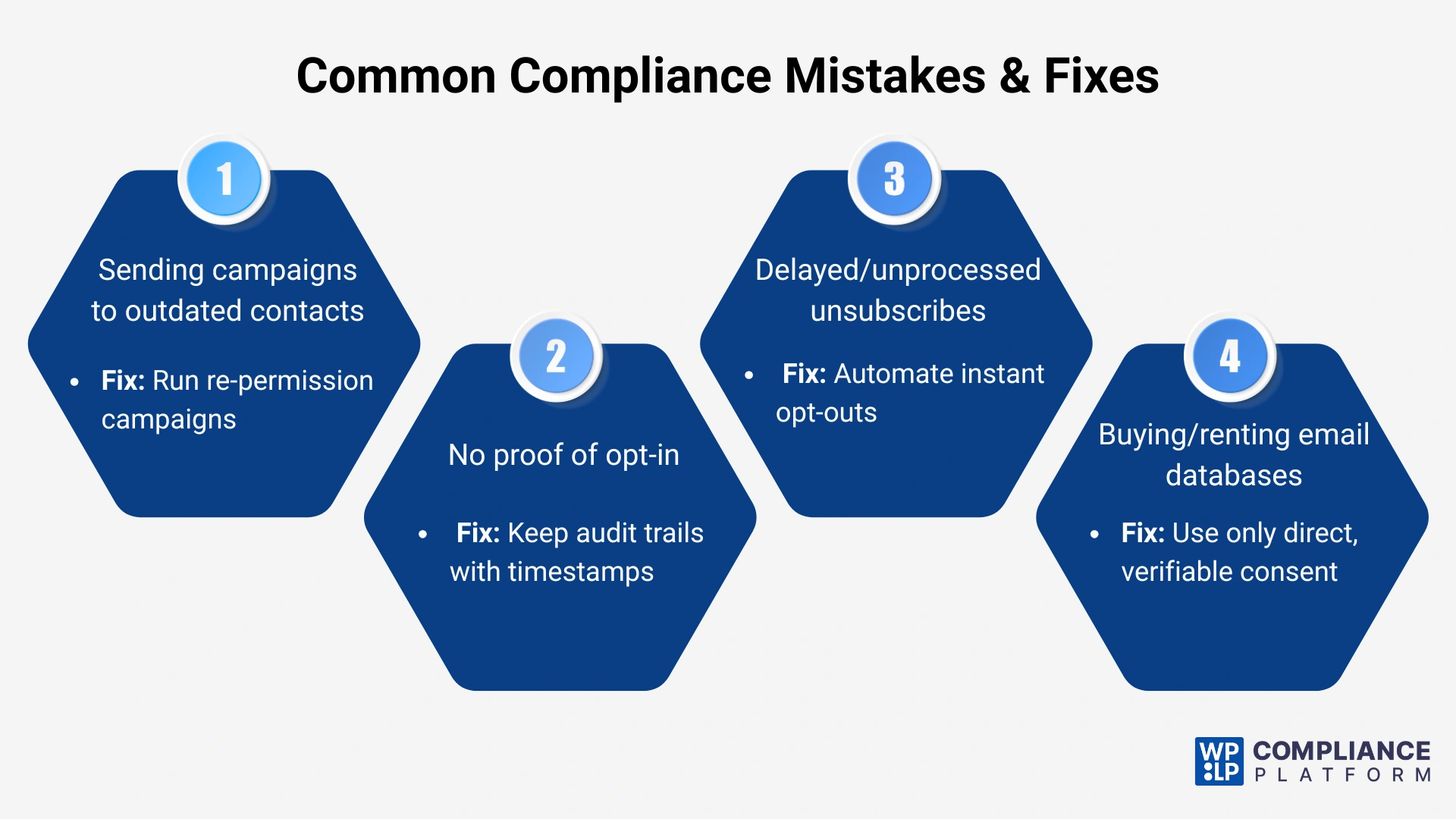
1. Sending campaigns to old lists without renewed consent.
Sending a campaign to the old list can be considered a serious breach of privacy laws. Old lists frequently contain people who never consented to receive marketing communications (at least, not explicitly) or have forgotten they signed up for anything.
How to Fix: Run a re-permission campaign. Send a straightforward email to your old list asking them to actively click a link or button to confirm that they still want to receive your messages. This keeps your list clean and engaged.
2. Inadequate record-keeping (“I think they opted in…”).
Assuming consent on the customer’s behalf is risky. If they decide to take issue, it may be down to you to prove they accepted consent.
How to Fix: Establish clear audit trails. Meaning your software needs to track and timestamp each action of consent on behalf of your user. There are audit tools and robust email marketing platforms where you can easily record this data and have undeniable proof of consent.
3. Not honoring opt-outs promptly.
Ignoring an unsubscribe request is a fast way to lose customer trust and be fined. There is usually a legal time frame for honoring that request.
How to Fix: Use automated systems for instant opt-out. Remove them when they click the unsubscribe link or send the “STOP” text. This indicates respect for the decision and compliance.
4. Using third-party databases or append services.
Using third-party lists is considered non-compliant. You also cannot be sure that the people whose information is on the list have given their consent. And you will be held responsible by law for this.
How to Fix: Do not use third-party lists. The only ethical and compliant way to create a marketing list is through direct, verifiable consent. This way, you know each contact on your list is there because they choose to be.
Now, let’s see some of the best practices and how the WPLP Compliance Platform can help you be audit-ready for compliance.
Best Practices for Capturing, Logging, and Managing Consent
Some of the best practices for compliance are.
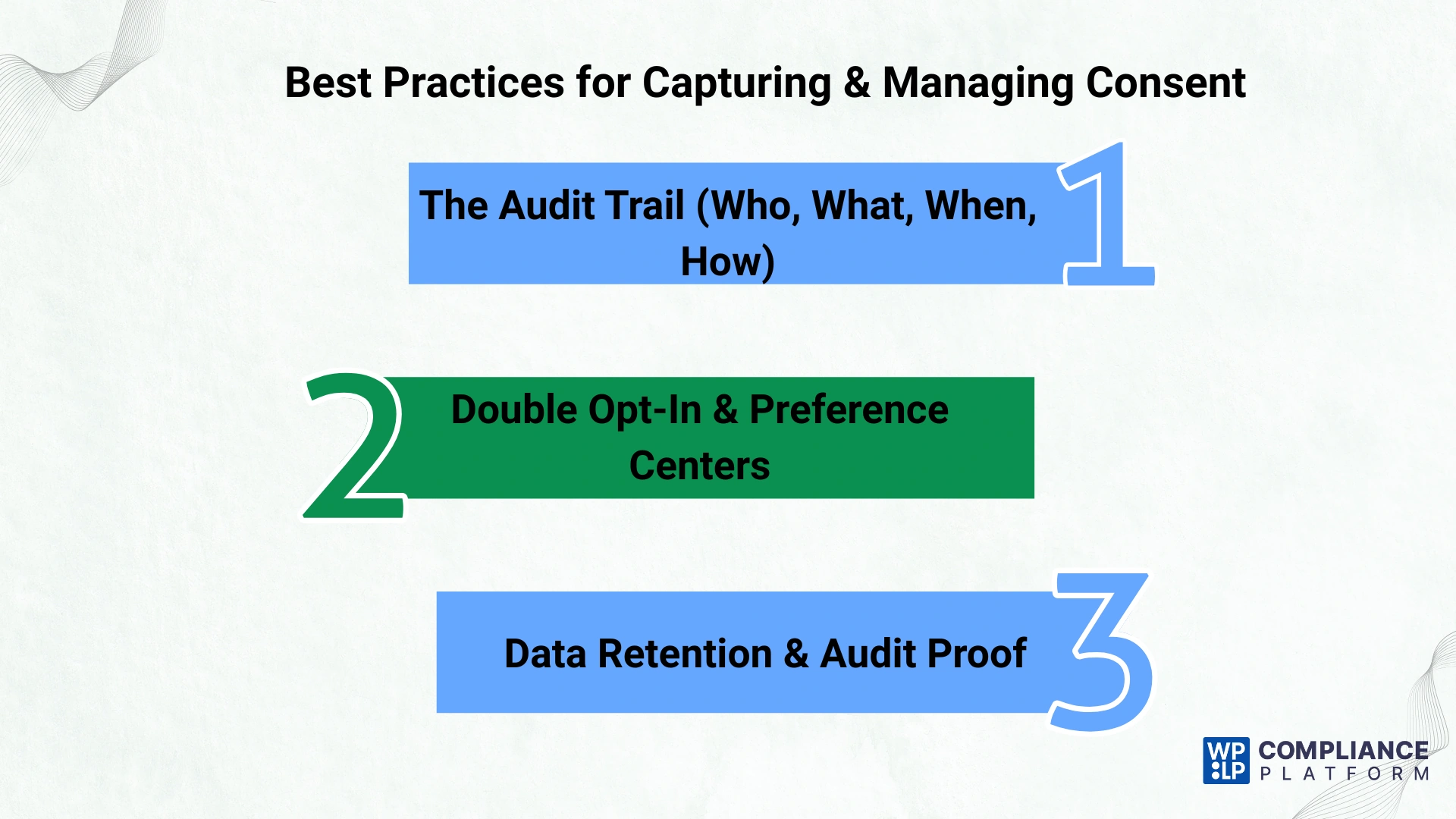
1. The Audit Trail: Who, What, When, How
In order to address the GDPR email consent best practices and similar SMS marketing privacy, you need a record of every opt-in. You want to log:
- Who: The user’s identification.
- What: The actual consent given.
- When: The exact time (date and time) of the consent.
- How: The method of consent, such as a web form, consent banner for email, or consent as part of the checkout page.
2. Implementing Double Opt-in and Preference Centers
Although Double opt-in is not required under many laws, it is still the best practice. In this case, if a user signs up on any page for a subscription, you send a confirmation email. It contains a link that they click on to confirm their subscription, and they have activated it.
It is irrefutable evidence of consent.
While you are following a marketing consent checklist, you would also want to include a preference center that enables users to freely update their preferences and opt-out.
If the GDPR governs your business, you’ll also need a process for the Data Subject Access Requests (DSAR) and have to handle “right to be forgotten” requests.
This helps you receive requests for data deletion.
3. Data Retention and Proof of Consent for Audits
You are legally accountable for showing proof of consent if the user sends in a DSAR or the regulator starts an audit on your company. Your system should:
- Retain: Maintain consent logs for a reasonable and defensible duration.
- Export: Your consent management system should allow for export of all consent records in a structured or report-ready format.
Now we will see some of the top tools for compliance.
Practical Tools for Automated Consent Compliance
Creating and maintaining a compliant marketing list does not need to be done manually. Numerous tools and platforms are available to automate most of the key compliance tasks, from capturing consent to logging consent for audits.
1. WPLP Compliance Platform
WPLP Compliance Platform, which is designed exclusively for WordPress development and use, is a complete WordPress consent management solution that goes beyond just generating legal pages.
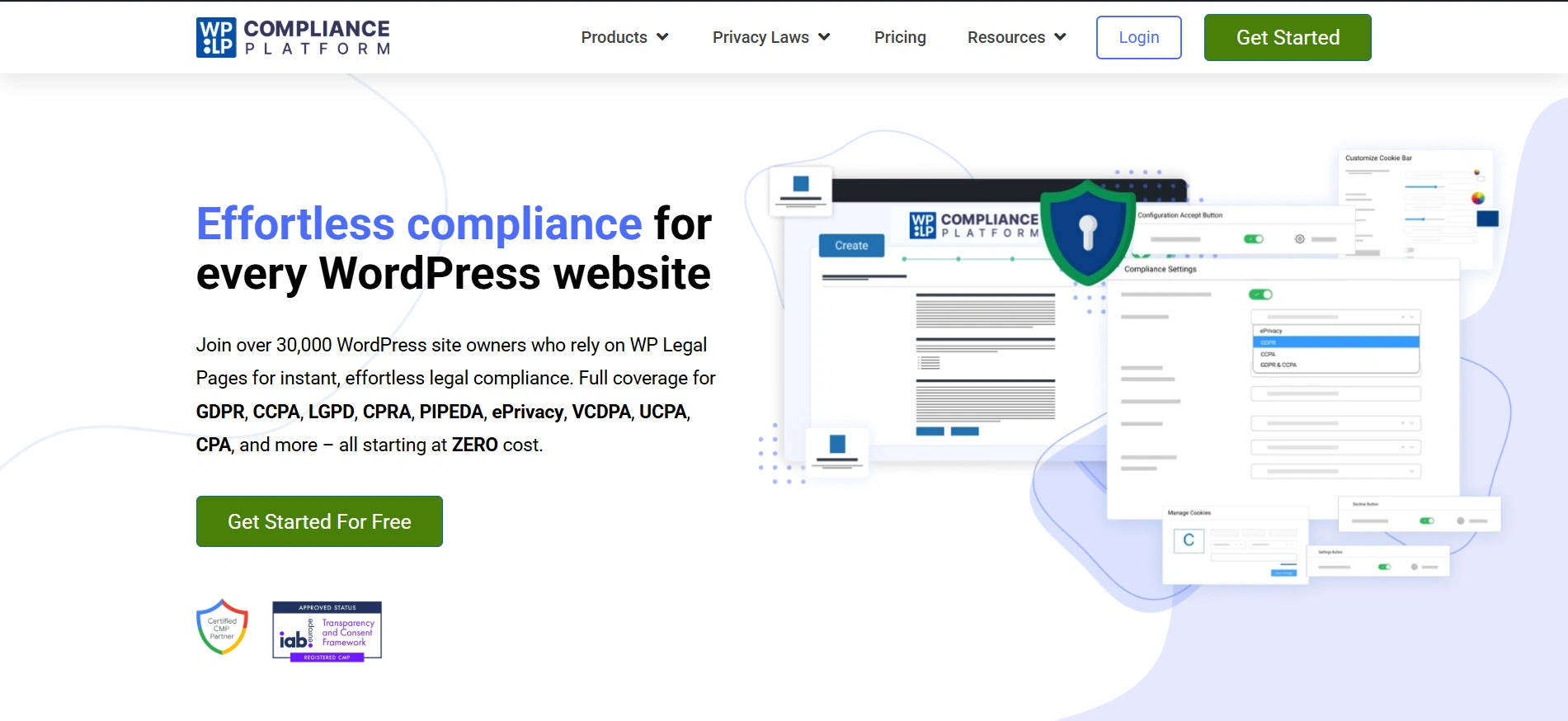
It is focused on automating the technical compliance features. The platform helps you with:
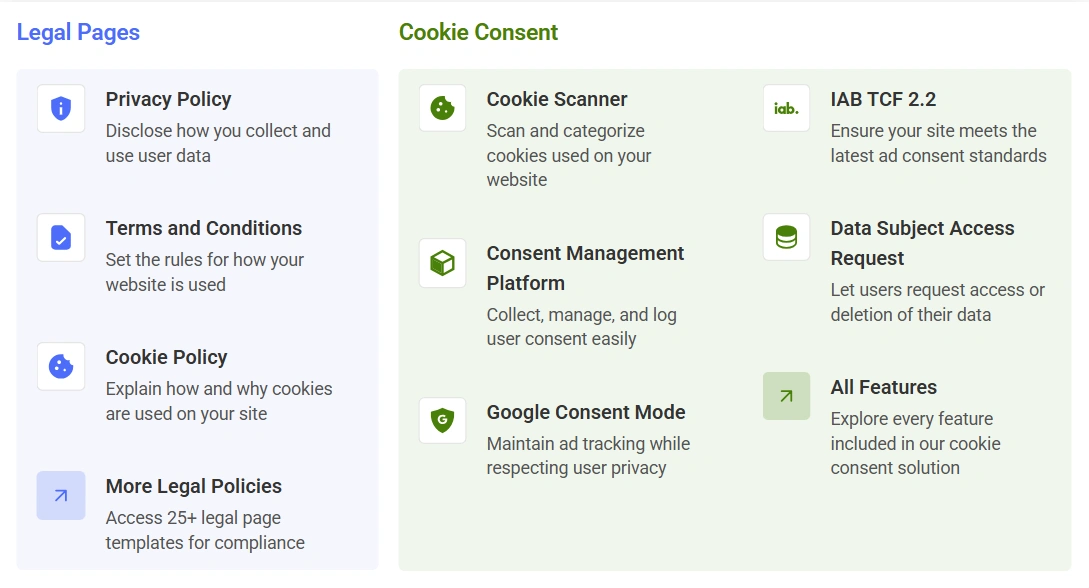
- Automated Cookie Consent Banners: You can automatically generate and display a cookie consent banner that is geo-targeted. This means it will only be displayed for users located in that area, which is a legal requirement.
- Log of consent data: The platform creates a detailed log for every consent that you collect. The log files contain the user’s IP address, time, browsing name, and the privacy policy they agreed to.
- Data Export/Deletion: This feature helps you simplify the process of DSARs by providing the ability to export or delete a user’s data.
- Integration: Full integration with your existing website, email marketing platform, and SMS marketing platform.
- Consent Mode v2 Support: Google Ads & Analytics tracking aligned with consent preferences.
The WPLP Compliance platform is designed for the WordPress ecosystem, making it a seamless solution for WordPress users.
The platform eliminates the need for different plugins for legal pages, cookie consent manager, and logging. It provides more than 30+ legally compliant pages and nine templates for cookie banners.
2. Mailchimp
Mailchimp is best known for its email marketing features, but it also has a range of built-in compliance tools.
It has built some GDPR friendly sign-up forms that allow marketers to obtain explicit consent for various marketing purposes through unchecked checkboxes for each of the pre-built fields within the forms.
In addition, you can use segmentation to deliver campaigns explicitly to subscribers who have given the proper permissions. And hence, only those subscribers receive messaging that is relevant to them, as stated in the consent from that marketing collection activity.
However, the Mailchimp-compliant features are mostly just around email compliance, as there is no native support for SMS marketing privacy.
Therefore, a business wanting a comprehensive, full compliance solution should look to integrate another tool outside of Mailchimp.
3. General SMS Marketing Plugins
For SMS marketing, businesses will require a dedicated plugin or platform since the compliance will differ from that of email.
Most of these tools are built for compatibility with widely used e-commerce and CRM platforms.
These tools offer you built-in opt-in and opt-out options, and they automatically check for specific keywords to trigger an action.
Most SMS platforms also maintain a consent log to keep track of opt-in and opt-out times for a reliable audit trail.
These tools are built with TCPA and CAN-SPAM compliance in mind and usually have a two-way messaging capability. Common choices of plugins include WP SMS Pro and OptinMonster (for SMS lead capture).
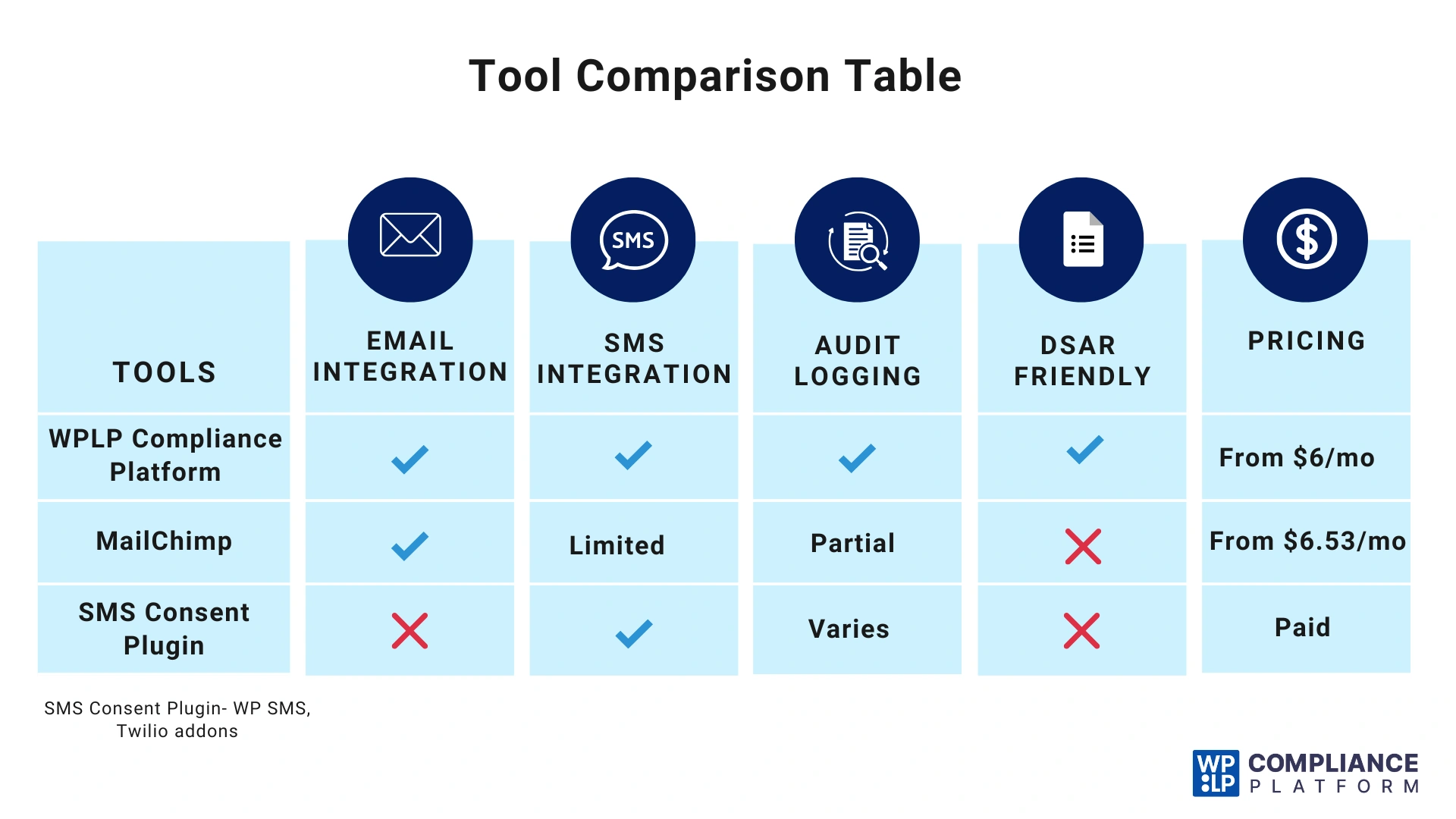
Responding to Complaints/Regulatory Checks
If you receive a data subject access request (DSAR) or a complaint from a regulator, having a solid, automated system is your best defense.
But managing these workflows manually is complicated, and there are chances of mistakes. Using the right tool is an available asset. Solutions like the WPLP Compliance Platform have features specifically designed to help WordPress users better manage consent logging.
The platform provides custom consent forms, auto-logs all user engagements, and exports structured audit-ready information with ease, meaning you can prove compliance with minimal effort.
As you can see in the screenshot, you can export the data request from the dashboard itself.
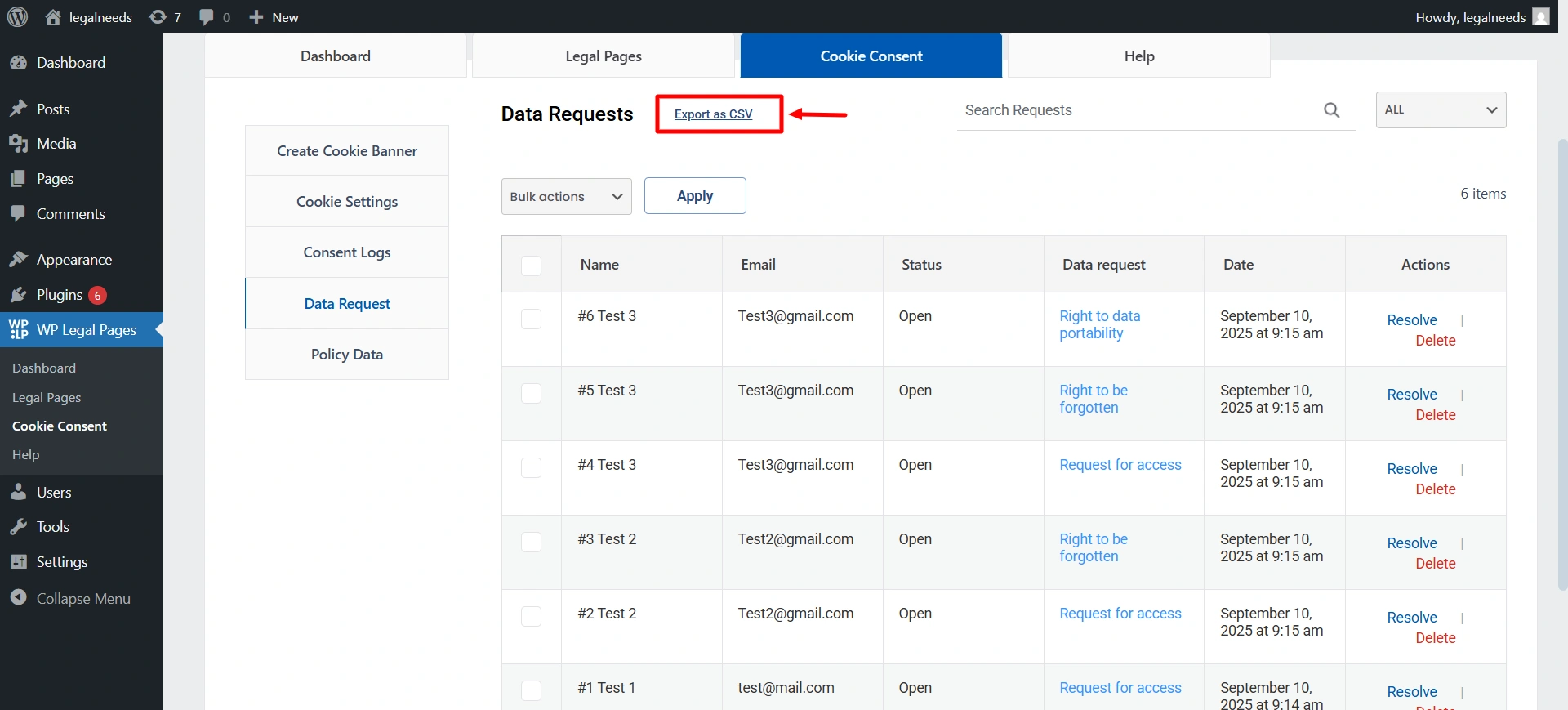
Checklist for Response:
- Verify the identity of the person making the request.
- Export the consent log for that individual from your compliance platform.
- Document the entire consent journey, including when and how they opted in, and any subsequent changes to their preferences.
- Provide this evidence to the regulator or data subject.
- Confirm that their opt-out was honored and on what date.
By following the proper checklist, you can build a robust, auditable system for managing customer consent. This proactive approach significantly reduces your risk of regulatory fines and data-breach complaints while improving customer trust.
Frequently Asked Questions (FAQ)
GDPR/PECR marks a consent as valid consent when given willingly, with clear information, for a specific purpose, and without any confusion. You must inform them of what they are consenting to, and you must make it easy for them to withdraw that consent at any time.
For SMS marketing, you must maintain a clear, auditable record of consent for each subscriber. You should record the timestamp, IP address, what consent was given, and a record of any opt-out request.
WPLP Compliance Platform automates key tasks such as displaying geo-targeted consent banners and forms.
Creates a secure, unchangeable audit log of every consent interaction. And it also helps in simplifying the process of exporting consent data for regulatory checks or DSARs. Further, it ensures that opt-out requests are honored promptly and automatically.
Under laws like the GDPR and CAN-SPAM, a request to opt-out must be honored “without delay.” Ten business days is commonly accepted as the standard timeline.
No. Laws like the GDPR state that consent must be given willingly. A pre-ticked box is not a valid consent in the eyes of the law. Violating the rules by using pre-ticked boxes can carry heavy fines. The user must actively choose to opt-in.
Conclusion
Email and SMS marketing are the most effective marketing consent channels that bring positive outcomes, but they require you to follow specific GDPR requirements.
There are global regulations such as GDPR, PECR, CAN-SPAM, and TCPA that state that you must capture, store, and manage consent in a specific way, or risk penalties, lost trust, and damaged reputation.
Following the best practices, such as double opt-in, clear preference, and timely opt-out processing, enhances customer trust.
The WPLP Compliance Platform covers a range of compliance requirements, including automation of cookie banners, consent logs, and DSAR workflows, right in WordPress.
Taking a proactive approach to consent not only protects your business financially but also develops a quality, engaged audience that wants to hear from you.
Disclaimer: This article is for informational purposes only and does not constitute legal advice. Regulations like GDPR, PECR, CAN-SPAM, and TCPA may vary by jurisdiction and change over time. Always consult a qualified legal professional or compliance expert for advice specific to your business.
If you like this article, consider reading:
- How to Prepare Your WordPress Site for the End of Third-Party Cookies
- Consent Audit and Logging: Best Practices & Tools for Compliance
- Avoid Dark Patterns Cookie Banners: Honest and Ethical Design for Compliance
For WordPress users, the WPLP Compliance Platform automates consent logging, DSAR handling, and consent banner compliance – all within your site.
